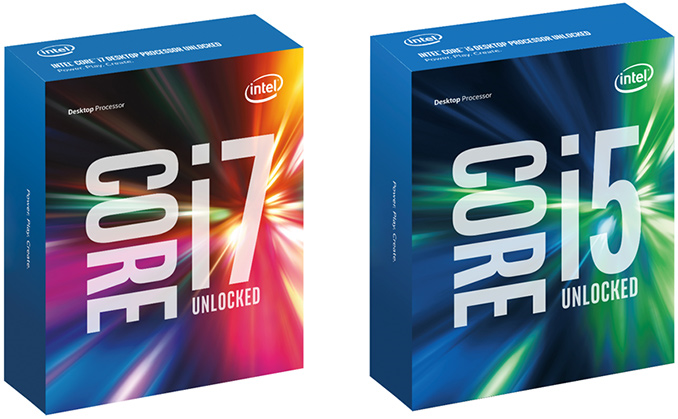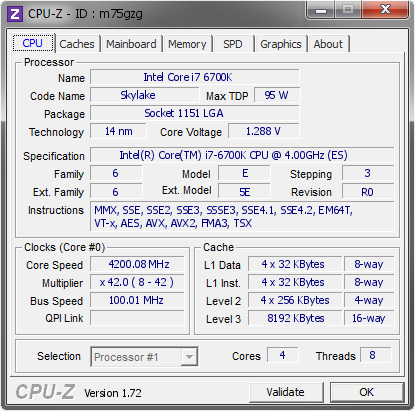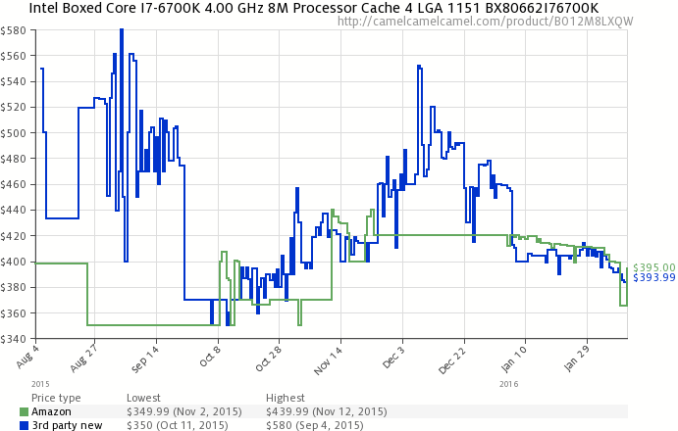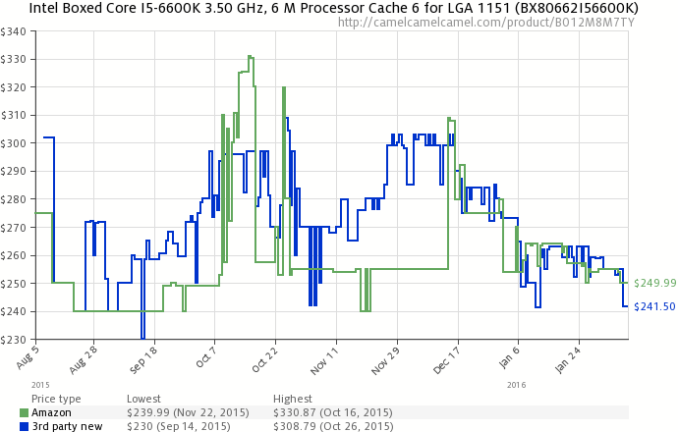Price Check: Intel’s Unlocked Skylake Processors for Desktops Are Getting More Affordable
by Anton Shilov on February 16, 2016 1:00 PM EST
Due to unprecedented demand, Intel’s latest Skylake processors with unlocked multiplier were significantly overpriced late last year. However, it would seem that more units are coming into retail as the popular Core i7-6700K and Core i5-6600K CPUs are becoming more readily available from multiple stores. As a result, actual retail prices of the chips have dropped in the U.S. retail in the recent weeks. Nonetheless, the most powerful Skylake-S is still listed above its suggested retail price.
Supply of Skylake-S Seems To Getting Better
Intel’s top-of-the-range processor for mainstream enthusiasts (before they make the step up to HEDT platforms), the Core i7-6700K (four cores with Hyper-Threading, 4.0 GHz/4.20 GHz, 8 MB cache, Intel HD Graphics 530 core, unlocked multiplier), has an MSRP of $350 according to Intel’s ARK. About six weeks ago, this processor in the US cost more than $420 at some stores, and was frequently in and out of stock of the biggest retailers.
However, this seems to be changing. Amazon currently (2/14) lists the Core i7-6700K for $365 but the chip is not in stock. According to CamelCamelCamel, a price-tracker that monitors Amazon and its partners, the Core i7-6700K was available from Amazon for $365 earlier this week, marking a significant shift in price. PriceZombie, which monitors Newegg, reports that the CPU is in stock and can be purchased for $412. According to NowInStock, the Core i7-6700K is available from multiple retailers but its price remains rather high (e.g., $395 – $412).
The Intel Core i5-6600K (four cores, 3.50 GHz/3.90 GHz, 6 MB cache, Intel HD Graphics 530, unlocked multiplier) is another chip in high demand by enthusiasts. The official price of the boxed version of the CPU is $243, but it was up to $290 in December. At present, both Amazon (CamelCamelCamel) and Newegg (PriceZombie) sell the part for $249 (2/14). Moreover, the Core i5-6600K CPU is readily available from a number of major retailers in the U.S., according to NowInStock.
As it appears, the availability of Intel’s Skylake-S microprocessors has improved since December and it is possible to get all the latest chips from Intel. The Core i7-6700K remains overpriced, it is still more expensive than the Core i7-5820K high-end desktop processor (six cores with Hyper-Threading, 3.30GHz/3.60 GHz, 15 MB cache, unlocked multiplier), which can be purchased for $379 – $385 in the U.S. Since the difference between the i7-6700K and the i7-5820K is now miniscule, for many people it makes no sense to invest in a HEDT platform, which involves purchase of an expensive Intel X99 motherboard and at least four memory modules.
Intel Boosts Shipments of 14nm Chips
According to Intel, starting from November, half of its client chips were made using 14 nm fabrication technology, which was a big breakthrough since the latest manufacturing process was a tough nut to crack for the chip giant. Intel had to delay mass production of its 14 nm CPUs from late 2013 to the second half of 2014 due to defect densities. The ramp up of mass production may mean that the defect densities are getting lower.
“As of November, 14nm products made up more than 50% of the client computing volume,” said Brian Krzanich, chief executive of Intel, during the Q4 2015 Earnings Conference Call with investors and financial analysts.
Starting from the third quarter of fiscal 2015, Intel has been using its Fab 24 manufacturing facility in Leixlip, Ireland, to produce its chips using 14 nm fabrication process. Earlier Intel produced its chips using this technology only in its D1D, D1C and D1X fabs in Hillsboro, Oregon. As Intel ramps up production at Fab 24, shipments of its latest microprocessors are growing. The chip giant does not readily disclose what exactly it produces and where, so it is impossible to say for sure that supply of higher-end Skylake-S models is gradually improving because of the Fab 24 ramp, although given what we do know it seems more than likely.
Nonetheless, it is evident that supply of Intel’s unlocked processors has gotten better, just like the share of Broadwell and Skylake CPUs has gotten higher in Intel’s shipments. At present Intel offers various 14 nm chips, including processors for desktops and laptops featuring Broadwell and Skylake micro-architectures, SoCs for tablets and notebooks based on Skylake and Airmont micro-architectures and so on. The company also plans to start shipments of its new Xeon processors featuring Broadwell-EP cores (as well as new Broadwell-E HEDT offerings) in the first half of the year.
Intel: Demand for Core i7 Sets Records
It is interesting to note that demand for higher-end Core i7 and unlocked processors set a record in fiscal year 2015, according to Intel. Strong demand for CPUs for gamers and overclockers partly explains deficit of Intel’s unlocked Skylake-S chips late last year.
“For the year, high-end Core i7 microprocessors and our K SKUs for gaming, both set all-time volume records, leading to our rich product mix,” Mr. Krzanich told investors and analysts.
If demand for high-end SKUs is so high, it is not surprising that Intel is allegedly trying to limit overclocking to its Core i7 Extreme (HEDT) as well as Core i7/i5-K product lineups. There is simply no need for the company to enable overclocking for lower-end models if users are eager to buy higher-end parts. Unfortunately, it is also evident that demand for the high-end Core i7-6700K is still high enough to drive the price up at the retailer.
Relevant Reading
Skylake-K Review: Core i7-6700K and Core i5-6600K - CPU Review
Comparison between the i7-6700K and i7-2600K in Bench - CPU Comparison
Overclocking Performance Mini-Test to 4.8 GHz - Overclocking
Skylake Architecture Analysis - Architecture
Non-K BCLK Overclocking is Being Removed - Overclocking Update













54 Comments
View All Comments
Artureld - Tuesday, February 16, 2016 - link
5960X + 3 way GTX 980 + Samsung 950 Pro, - no reason to upgrade yet! Come on Intel... :pmapesdhs - Tuesday, February 16, 2016 - link
"Due to unprecedented demand ..."Nah, more like simple lack of supply. When the supply is short, normal levels of demand will create price spikes.
It hasn't changed that much though, eg. in the UK the 6700K is still a ridiculous 300 UKP ($450).
Achaios - Tuesday, February 16, 2016 - link
I agree with the above poster.Can't really see for the life of me, why people, all of a sudden, would feel an insurmountable need to throw their 2500k/2600k/3770k/4770k systems overboard the vessel and rush to the stores to get Skylake for QUOTE usb 3 , sata6 , nvme , pcie 3 UNQUOTE.
I haven't managed to find a use for my USB 3.0 port yet, SATA 6 is meh, don't even know or care what on earth is nvme, and I can't see how my GPU benefits from PCIE 3.0, really, I can't.
4770k/Z87 Maximus Hero/Gigabyte GTX 780 TI here.
TomWomack - Wednesday, February 17, 2016 - link
USB3 is handy because your external backup drive nowadays runs faster than USB2 can manage, but USB3 cards plug into a PCIe slot. NVMe is fast, but the adaptor to plug an nvme into a PCIe slot is $60 or so. So if you have two spare PCIe slots of any length you're fine.Nfarce - Wednesday, February 17, 2016 - link
Then like Tom said, you must not work much with an external USB drive (flash drive or HDD specifically). There's a world of difference in file transfer speeds between 2.0 and 3.0 in large volume transfers. For example, moving 40GB of data on my 3.0 64GB flash drive via 3.0 takes about 25 minutes. Doing the same on an older 2.0 laptop, it takes two hours. And when dealing with getting into the TB worth of data like with my 2TB external Seagate USB 3.0 drive, the difference becomes *many* hours...like most of the day....not just an hour or two.bug77 - Wednesday, February 17, 2016 - link
Yes, I don't see the "unprecedented demand" either. PC sales are steady at best and I don't think all Celeron/Pentium/i3 users suddenly felt the urge to upgrade to i5/i7. It's simply intel taking advantage of AMD's (extremely) weak position in the market. And a sign of things to come if AMD doesn't get their act together.Senti - Tuesday, February 16, 2016 - link
"Since the difference between the i7-6700K and the i7-5820K is now miniscule, for many people it makes no sense to invest in a HEDT platform" – so, you think that getting for the same price 50% more cores is miniscule difference that makes no sense to invest in? Indeed, indeed...Also, Intel X99 motherboards are not that more expensive – most people who are getting i7-6700K definitely would not pair it with cheapest socket 1151 motherboard.
Senti - Tuesday, February 16, 2016 - link
"at least four memory modules" on X99 is also nonsense – it will work with 1, 2 or 3 modules with no problem. If you plug just 2 – you'll get the same two memory channels as on Skylake.Madpacket - Wednesday, February 17, 2016 - link
Yeah that was a dumb statement by the author. X99 boards with tons of features can be had for under $250 and the 5820K even with only dual sticks will outperform the 6700K in almost every multi threaded scenario. Plus you have the option of eventually upgrading to 10 core Broadwell and 8 slots for memory give you enormous upgrade potential. Why anyone would buy a Z10 + 6700K over X99 + 5820K is beyond me.britjh22 - Wednesday, February 17, 2016 - link
Yeah, this article sounds like someone regurgitated an Intel press piece."There is simply no need for the company to enable overclocking for lower-end models if users are eager to buy higher-end parts."
Fuck everything about that, I miss the Intel of the C2D days, when they had a wide range of interesting products, instead of a regimented table worked up by accountants with 5% actually being interesting.